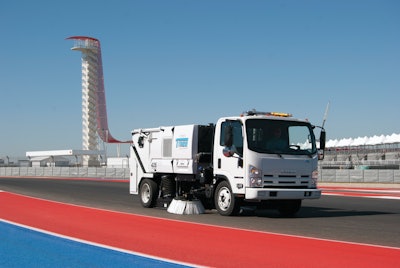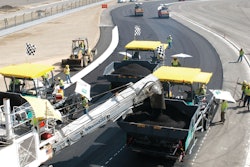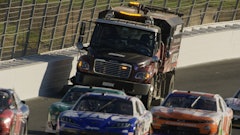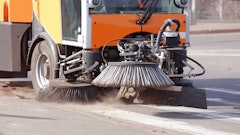
Three Tymco sweepers took to the track at dawn on Nov. 18, completing the final preparations for the first Formula One race in the United States since 2007. The Circuit of The Americas F1 facility is located in Wandering Creek, TX, southeast of Austin. With so much at stake, the pressure was on for crews to successfully complete the important task of sweeping the track before drivers took to their cars. BMP Specialist, located in Austin, TX, swept the track with assistance from the track crew.
The type of equipment used for sweeping the track was extremely important both in purchasing a unit for the track as well as finding the best choice for local contractors. With the fast pace of the race, it was crucial to choose a unit that could quickly and efficiently clean up the track. After researching available options for sweeping equipment, Lon Bromley, director of safety for Circuit of the Americas, felt that the Tymco units were the best machine for the job.
“During the race, we will use oil absorbent to pick up an oil spots on the track,” Bromley says. “We have to get that material off the track and into a containment system—like the Tymco sweepers—fast. We have to be able to pick up the material on the first pass through because time is critical on a race track. The quality of machine is extremely important to us.”
The track purchased one Tymco Model 435 and BMP utilized two Tymco Model 600’s for the race. The track unit is equipped with 4 cubic yard hopper capacity high dump and polybrooms—a broom that is typical of airports and race tracks. BMP’s units are equipped with a 6 cubic yard hopper.
As for sweeping the track, the Regenerative Air units push the debris to the surface with a blast of air at 170-200 mph moving the debris up and out of the cracks on the track. Taking about an hour and a half, the units operate at a maximum speed of 7-8 mph in order to properly pick up the debris.
On the morning of the race, crews were out on the track at dawn using the three units to sweep again in tandem. One will operate high on the track, one down in the middle, and one down on the edge of the track to cover the most area in the shortest period of time. The material picked up during the sweep was less than 1/3 of the hopper.
“Crews are sweeping to make sure the track is completely clean,” Bromley says. “I will do a final inspection of the track after it is swept and the areas with oil are cleaned up to make sure it is ready for the drivers.”
Two other races took place before the main Formula 1 race. As a result, crews swept the track once after each race. “It’s key to remember that while most of the track is asphalt, the drivers don’t always stay on the asphalt,” says Chuck Aksland, vice president of Motorsport Operations. “They’ll use as much of the track as possible so they are always kicking up rocks and debris. If you hit a little pebble at 200 mph it can be a pretty dangerous situation.”
Unlike some tracks, this one is extremely wide with additional areas that have been paved. “The track is flat with a lot of hills,” Bromley says. “We not only have an area the guys will race on, but there is also a lot of runoff area that has been paved. We will have to clean that area, too.”
The sweepers’ work didn’t end there. Once the race began the units were strategically placed at specific turns in case an incident would occur; however, this race did not require any cleanups. Nonetheless, BMP had two sweepers located at Turn 5 while the track sweeper was located at Turn 19 in order to quickly and efficiently cleanup any debris during the race.
While making sure the track is free of debris is crucial, it is also important to note that the crews avoid sweeping the track too much. “If there are no problems during the race we try not to sweep unless necessary,” Bromley says. “The buildup of rubber is very important to the traction the car has on the race track. So, the more you sweep and play with the surface it will change the way the cars are going to handle on the track. Once the drivers get used to the track we don’t want to mess with it unless we have to.”



![Pavement Awards 2025[main]](https://img.forconstructionpros.com/files/base/acbm/fcp/image/2024/05/PavementAwards_2025_main_.665883e4276e8.png?auto=format%2Ccompress&bg=fff&fill-color=fff&fit=fill&h=100&q=70&w=100)







![Pavement Awards 2025[main]](https://img.forconstructionpros.com/files/base/acbm/fcp/image/2024/05/PavementAwards_2025_main_.665883e4276e8.png?ar=16%3A9&auto=format%2Ccompress&bg=fff&fill-color=fff&fit=fill&h=135&q=70&w=240)







